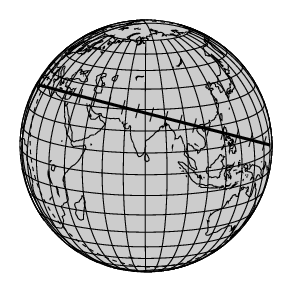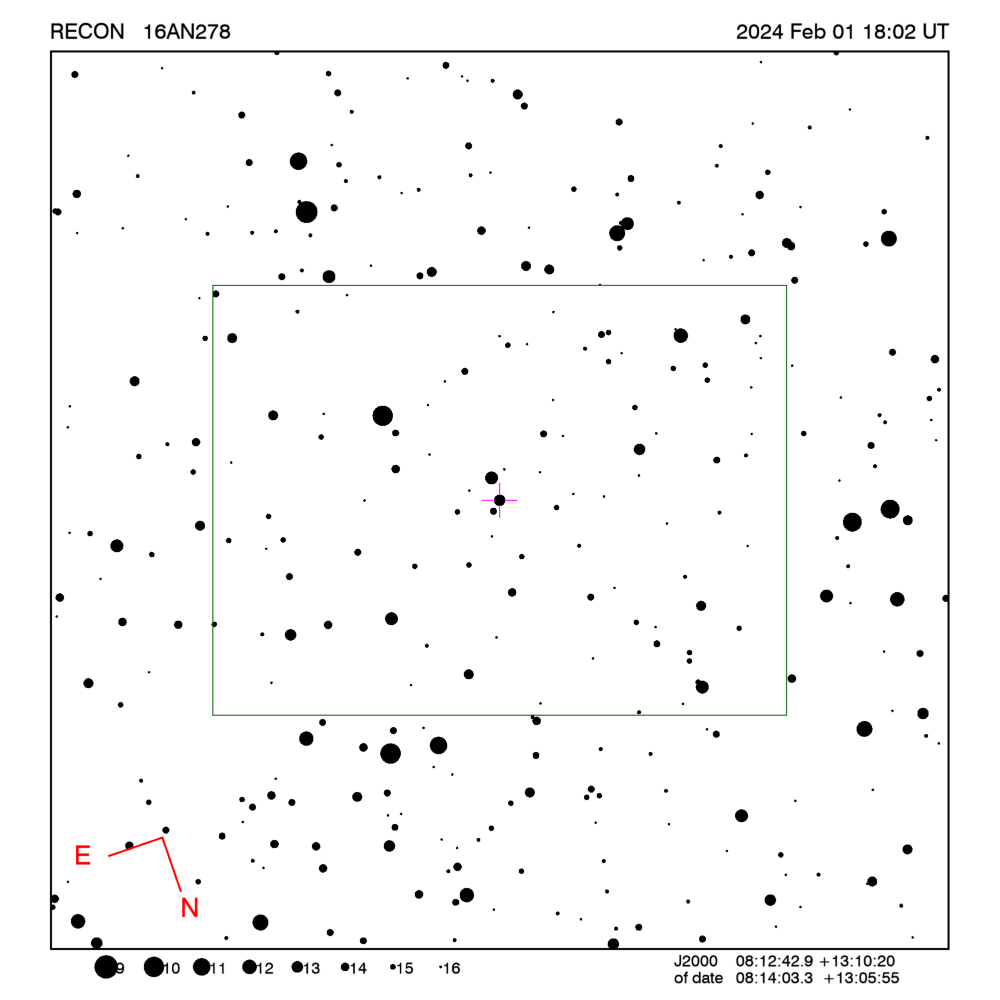RECON: TNO occultation with 16AN278
Event between 16AN278 and star GA1020:03118176
with event index number of 1950316
Geocentric closest approach at 2024/02/01 18:05:24 UTC
J2000 position of star is 08:12:42.9 +13:10:20
Equinox of date position of star is 08:14:00.2 +13:06:05
Stellar brightness G=13.4,
use SENSEUP=32 with the MallinCam and and exposure
time of 500 milli-seconds with the QHY174 camera.
Star is 86 degrees from the moon.
Moon is 62% illuminated.
Apparent brightness V=22.6
 Object is 37.2 AU from the Sun
and 36.2 AU from the Earth.
Object is 37.2 AU from the Sun
and 36.2 AU from the Earth.
Apparent velocity is 24.5
km/sec on the sky relative to the star, or,
3.4 arcsec/hr.
The 1-sigma error in the time of the event is 137 seconds.
The 1-sigma cross-track error in the shadow position is
1690 km.
The object has an absolute magnitude Hv=6.9
Diameter=245.5 km assuming a 5% albedo -- 10.0 sec chord
Diameter=100.2 km assuming a 30% albedo -- 4.1 sec chord
Dynamical classification is SCATNEAR
Star training set for 16AN278, (2024/02/01 18:02UT)
Object RA Dec mag sep mel
Pollux 07:46:47.3 +27:57:58 1.1 16.17 96
PPM 124962 08:12:19.9 +14:33:24 6.3 1.52 87
PPM 125025 08:15:41.2 +12:58:25 7.5 0.42 86
PPM 125017 08:15:14.4 +13:02:34 9.3 0.29 86
16AN278 08:14:03.3 +13:05:55 13.4 86
Positions are for equinox of date

Azimuth is measured in degrees eastward from north.
North is at an azimuth of 0, due East is at an azimuth
of 90 degrees, due South is 180, and due West is 270.
Do not use the listing below for the RECON CPC 1100 telescopes.
This is provided for other non-team facilities.
Star training set for 16AN278, (2024/02/01 18:02UT)
Object RA Dec mag sep mel
Pollux 07:45:17.9 +28:01:33 1.1 16.17 96
PPM 124962 08:10:58.8 +14:37:46 6.3 1.52 87
PPM 125025 08:14:21.0 +13:02:54 7.5 0.42 86
PPM 125017 08:13:54.1 +13:07:02 9.3 0.29 86
16AN278 08:12:42.9 +13:10:20 13.4 86
Positions are for J2000
Event circumstances last updated at 2023/03/04 03:50:29 UT
Marc W. Buie,
Southwest Research Institute
RECON
 Object is 37.2 AU from the Sun
and 36.2 AU from the Earth.
Object is 37.2 AU from the Sun
and 36.2 AU from the Earth.
